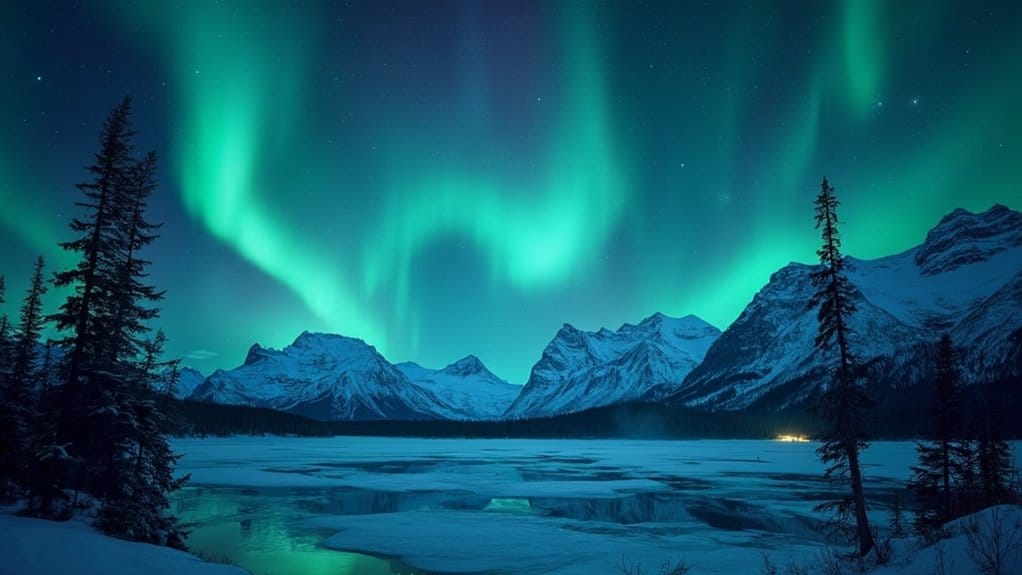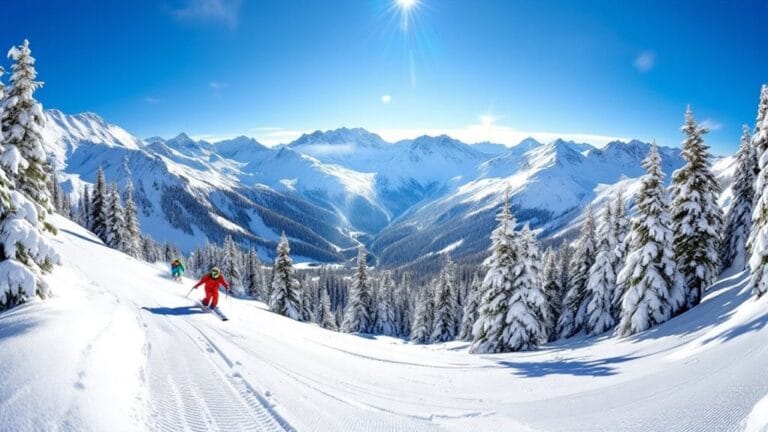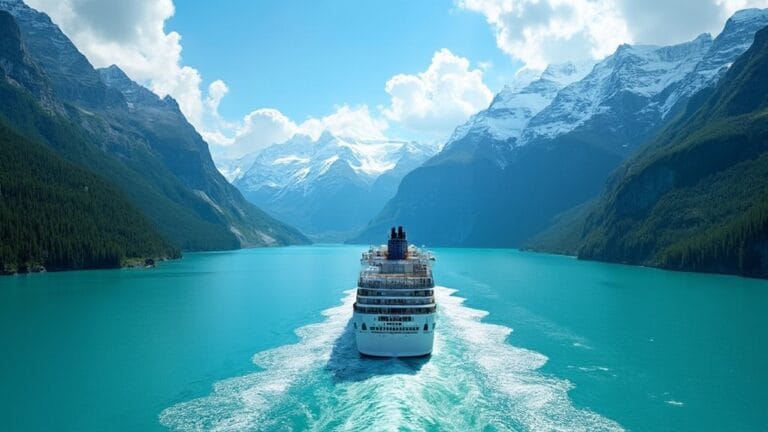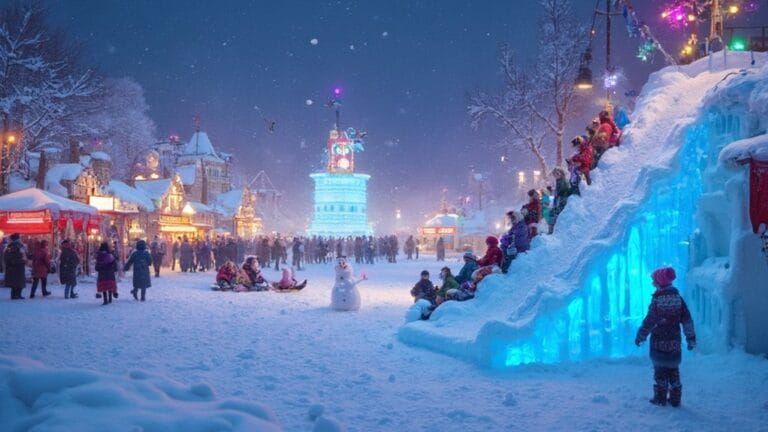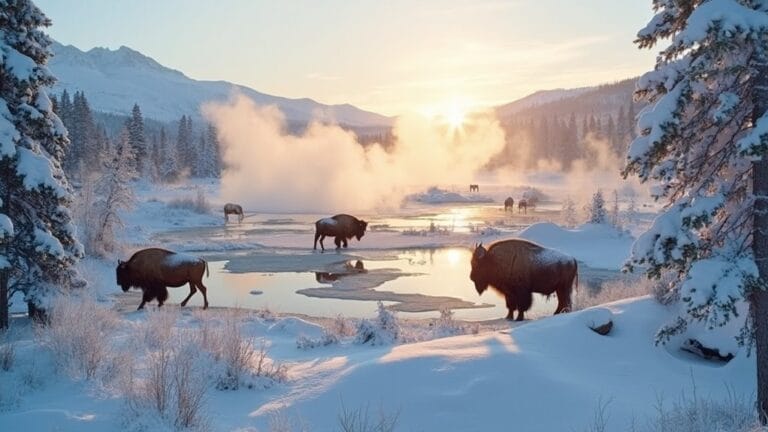If you're itching to catch Alaska's stunning Northern Lights, aim for late September to early April. March and September are prime time since the equinoxes crank up solar activity—think vibrant greens and purples dancing across the dark sky. It's best to scope out places like Fairbanks or Chena Hot Springs, where the views are postcard-perfect. You'll want to peek outside between 10 PM and 2 AM, on clear, dark nights, of course. Bundle up, grab some hot cocoa, and get ready for jaw-dropping moments! Trust me, there's a whole lot more magic waiting to be uncovered!
Key Takeaways
- The best time to view Alaska's Northern Lights is from September to April, with peak months in March and September.
- Clear, dark skies are crucial; avoid cloudy nights and light pollution for optimal viewing.
- Late evening to early morning (10 p.m. – 2 a.m.) offers the prime window for aurora sightings.
- Fairbanks is an ideal location due to its position under the auroral oval and frequent sightings.
- Monitoring aurora forecasts can enhance your chances of witnessing the Northern Lights.
Best Viewing Months
When it comes to catching Alaska's stunning Northern Lights, the best months to visit are between September and April. Trust me, you don't want to miss this magical experience! The nights are longer, and the skies are darker, creating the perfect backdrop for those vibrant auroras. If you're looking for the peak months, March and September are your best bets, as they coincide with equinoxes when solar activity is at its highest. March is particularly favorable because the spring skies tend to be clearer, which means more chances to spot those dazzling lights. It's like nature's own light show, and you'll definitely want to grab a front-row seat! April still offers good opportunities, but keep in mind that the nights are starting to get shorter. Interestingly, January and February are also highlighted as excellent months due to high activity levels and clearer conditions. Now, if you're planning a trip in May or June, you might want to reconsider, unless you're keen on the midnight sun. The sun doesn't set at all, making it tough to catch the auroras. Early season viewing in October can be promising, especially in Fairbanks, as the evenings grow darker. So, gear up and get ready to chase those lights!
Optimal Viewing Times
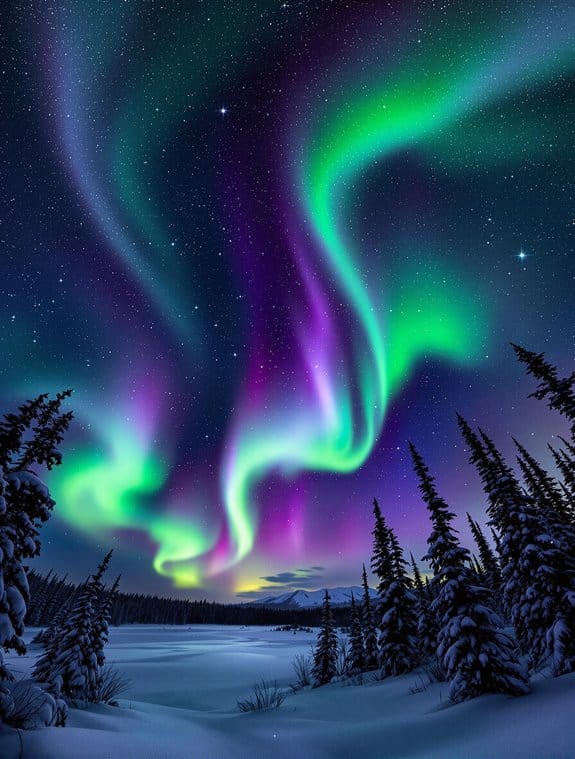
To maximize your chances of witnessing Alaska's breathtaking Northern Lights, timing is everything. You'll want to plan your viewing between 10 p.m. and 2 a.m. when the sky is darkest and the auroras are at their most active. If you can, aim for that sweet spot around midnight to 2 a.m., as that's when geomagnetic activity peaks. Trust me, it's worth staying up late for!
Now, while you're out there, keep an eye on the sky from about 9:30 p.m. to 1 a.m. to catch those magical moments. Remember, clear and dark skies make all the difference! You don't want to fight through city lights or the glow of towns. So, escape to a quieter spot if you can. And hey, checking aurora forecasts is a smart move! They'll give you the heads-up on when to expect the best displays. Additionally, it's often recommended to spend at least three nights in Fairbanks for a 90% chance of seeing the aurora.
Picture this: you're bundled up, sipping hot cocoa, and suddenly the sky dances with green and purple ribbons. It's pure magic! So, grab your warmest gear, stay patient, and get ready for an unforgettable night beneath the Alaskan sky.
Ideal Locations in Alaska
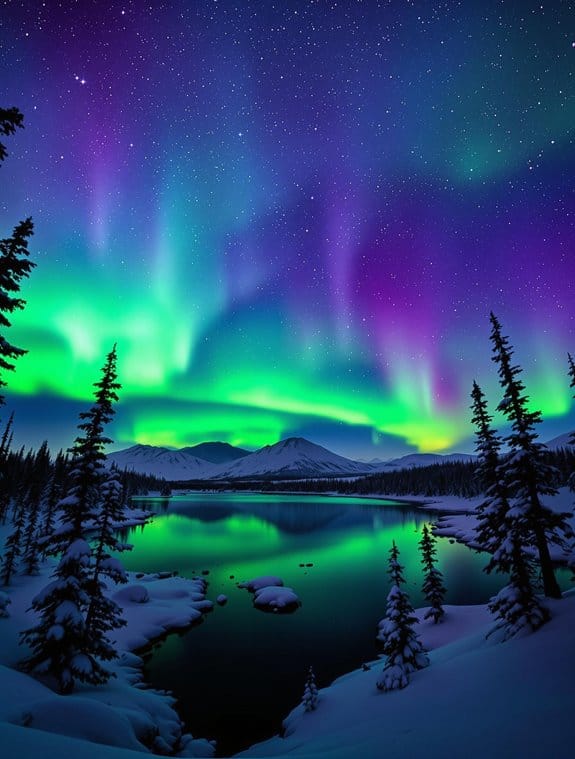
Alaska boasts some of the best locations for viewing the Northern Lights, each offering unique experiences and stunning scenery. If you're in Fairbanks, you're in luck! It's right under the auroral oval, so you'll see those dazzling lights often. Just 61 miles away, Chena Hot Springs Resort gives you the bonus of soaking in hot pools while you gaze at the night sky. What a way to warm up!
If you're feeling adventurous, head to Murphy Dome, a former Air Force station. At 2,930 feet, the views are spectacular—no trees or buildings to block your view of the lights! Coldfoot is another gem, tucked away on the Dalton Highway, where the remote setting means clear, dark skies. During the winter months, peak Aurora activity occurs between midnight and 5 AM, making it an ideal time to experience the lights.
Even Anchorage has some great spots. Glen Alps offers high elevation, while Point Woronzof boasts a coastal view with minimal light pollution. Eklutna Tailrace and the Knik River Valley provide unobstructed horizons, perfect for those stunning displays. And don't forget Girdwood—it's shielded by mountains, so you can enjoy a cozy, light-show wake-up call. Each spot promises a magical experience, so grab your camera and get ready to be amazed!
Factors Influencing Visibility
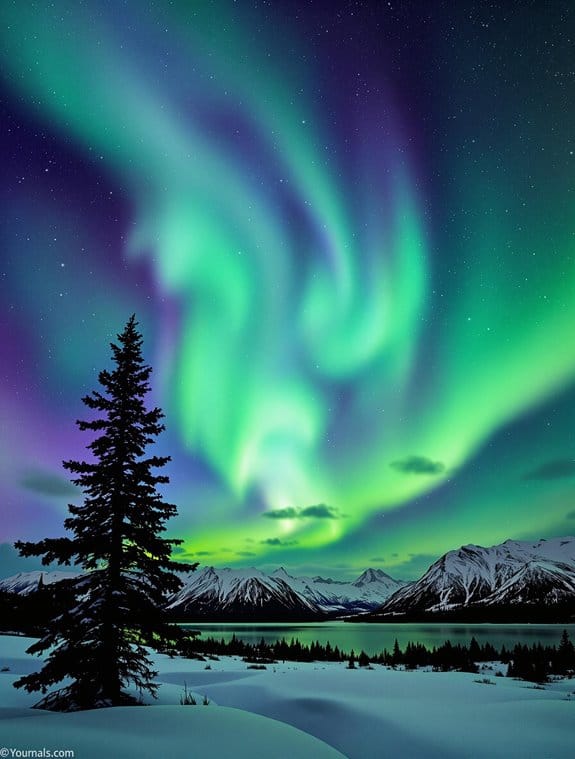
Seeing the Northern Lights depends on several key factors that can make or break your experience. First off, solar activity is essential. The more active the sun is, the better your chances of witnessing those stunning lights dance across the sky. You can keep tabs on this with NOAA's aurora forecasts—trust me, it's worth it!
Next, darkness and weather play huge roles. You'll want clear, dark skies, so steer clear of cloudy nights and light pollution. New moons are your friends here, giving you that extra boost in visibility. Additionally, the best viewing locations are often found in the northern parts of Alaska, where the aurora is most frequently visible.
Don't forget about geomagnetic activity! During those exciting geomagnetic storms and solar flares, the aurora shines even brighter—often peaking between midnight and 2 AM.
Timing is everything, too. The best months for viewing are mid-September through early April, especially during winter when nights are longest. And when you're out there, aim for the sweet spot between 10 PM and 2 AM. That's when the magic really happens! So, bundle up, grab a warm drink, and prepare for an unforgettable show in the Alaskan sky.
Planning Your Trip
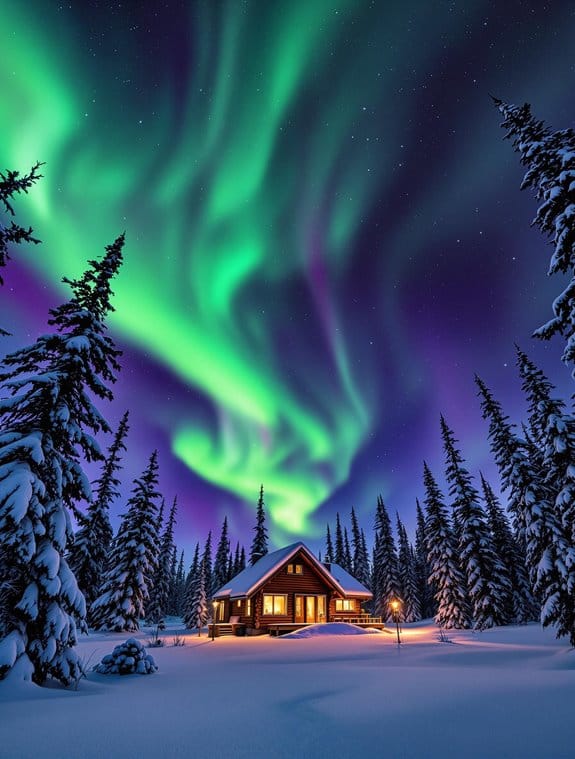
When planning your trip to experience the Northern Lights, timing and location play an essential role in maximizing your chances of witnessing this breathtaking phenomenon. The best months to visit are from late August to mid-April, when those long, dark nights offer prime viewing opportunities. If you can, aim for a stay of three nights or more in Fairbanks, as this will really up your odds of catching the lights dancing across the sky.
Now, let's talk about when to step outside. The late evening to early morning hours, specifically between 10 p.m. and 2 a.m., are your golden hours. If you want the best shot, be ready to bundle up and venture out between midnight and 3 a.m. Best viewing occurs during the autumnal equinox, when the nights are longer and darker, making it an ideal time for aurora sightings.
Location matters, too. Fairbanks and the surrounding remote areas are ideal since they're close to the auroral oval. Make sure to escape the city lights—nothing ruins a magical moment quite like light pollution! Keep an eye on aurora forecasts and look for nights with clear skies, and you'll be all set for an unforgettable experience under Alaska's shimmering night sky.
Recommended Tours and Activities
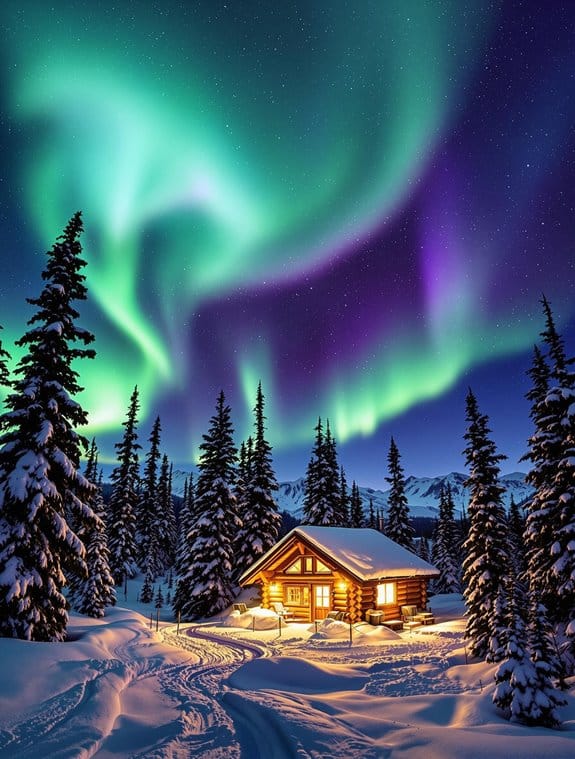
Experiencing the Northern Lights can be even more magical when you join a tour or participate in unique activities designed to enhance your adventure. Envision cozying up in a warm hut while ice fishing, all while the auroras dance overhead. For around $220, you can enjoy a five-hour session from November to March, which is a steal for such a breathtaking view!
If you're after some extra pampering, check out the Aurora + Hot Springs tour at Chena Hot Springs Resort. For about $230, you can soak in the hot springs and explore the Ice Museum while waiting for the lights to shine. This experience is complemented by nightly excursions for Northern Lights viewing, ensuring you have plenty of opportunities to witness this natural wonder.
For the ultimate experience, consider a multi-day Northern Lights tour that combines dog sledding, snowmobiling, and, of course, plenty of aurora viewings. This 6-day adventure includes guided excursions, all meals, and accommodations for about $2,958.
And if you want something truly unique, why not spend the night in a clear-roofed igloo? Visualize this: lying in bed, gazing up at the auroras, feeling like you're in a dream. It's an unforgettable way to embrace Alaska's winter wonderland!
Frequently Asked Questions
What Should I Wear to Stay Warm While Viewing the Lights?
When you're out in the cold, layering's your best friend. Start with a snug thermal base, add a cozy fleece mid-layer, and top it with a waterproof jacket. Don't forget warm boots and accessories!
Can I See the Northern Lights From My Hotel Room?
You can see the Northern Lights from your hotel room, but it depends on the location. Choose a hotel with minimal light pollution, ideally with north-facing windows or private balconies for the best experience.
Are There Any Safety Concerns While Viewing in Remote Areas?
When you venture into the icy wilderness, remember that the enchanting auroras won't protect you from extreme cold. Dress warmly, stay with a group, and be aware of your surroundings to guarantee a safe experience.
How Long Do the Northern Lights Typically Last During a Viewing?
Northern lights can last anywhere from a few minutes to several hours. You might witness brief displays or enjoy longer ones during peak solar activity, so be ready for an enchanting experience whenever they appear.
Is There an Age Restriction for Northern Lights Tours or Activities?
For instance, if you're considering a tour with Greatland Adventures, you'll find a minimum age of 13. Different operators have varying restrictions, so it's wise to check specific details before booking your Northern Lights experience.

